#19:
Healthy Communities understand Natural Areas
Manitoba’s
Wildlife Management Areas -Towards a Vision |
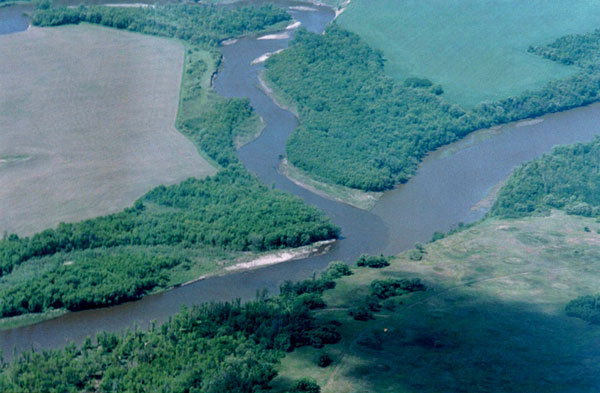
The Souris River enters the Assiniboine in the Assiniboine Corridor Wildlife Management Area
In Chapter 9 I introduced the topic of Wildlife Management Areas, and reported on my interaction, some years ago, with the Manitoba Government on the issue. A recent visit to one of our favourite spots brought the subject back - and sadly, the situation has not improved.
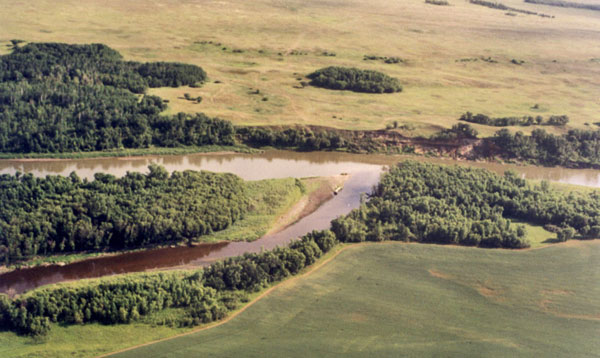
The damage and litter are occurring all along the north side of the river, a place easily accessed by vehicles.
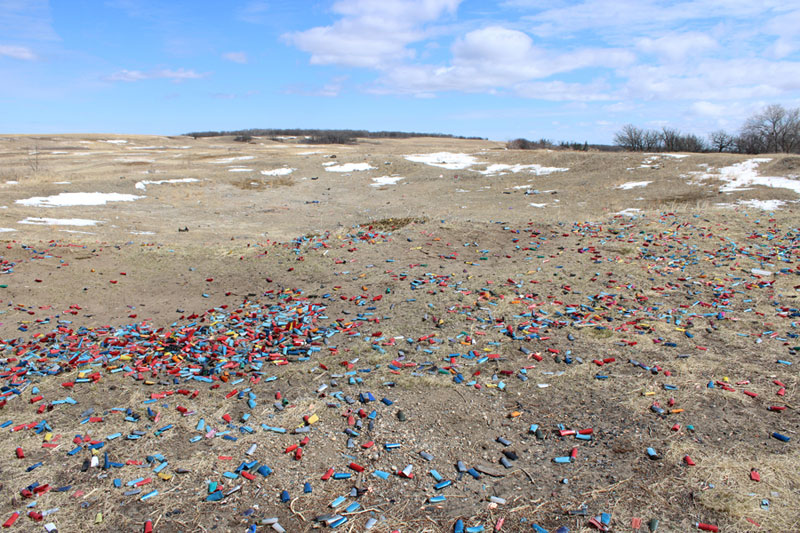
The target shooters have
taken over a large area and trashed
it. This has been going on for years.
The area directly overlooking one of the most historically significant places in Southwestern Manitoba is littered with shotgun shells.
The target shooters have taken over a large area and trashed it. This has been going on for years.
Video of the above of the Site...April 16, 2021
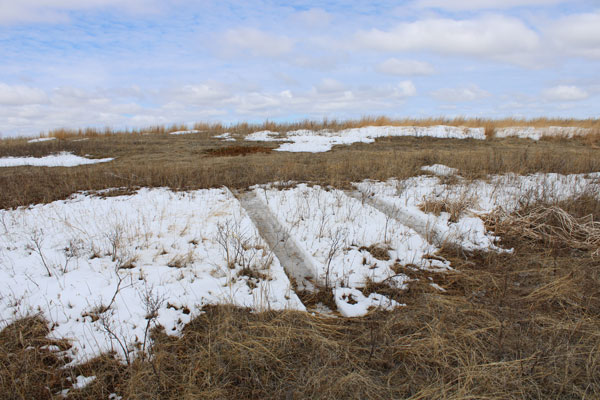
Truck and ATV tracks criss cross the whole area. They have made the area their playground.
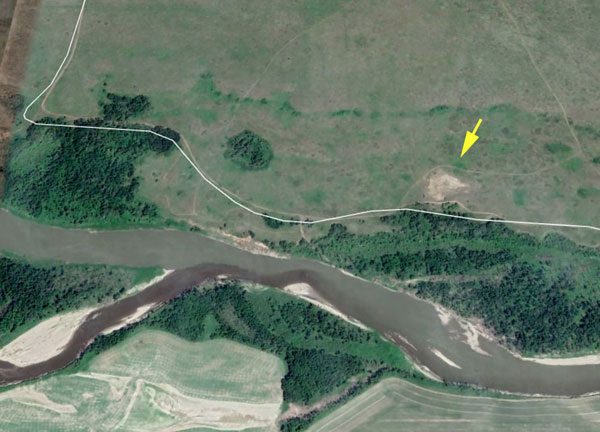
The most extensive area being trashed is visible on Google Earth.
The idea that “enforcement officers” would have any chance of catching litterers and vandals in the act is preposterous, given the low level of priority placed on the WMA’s.
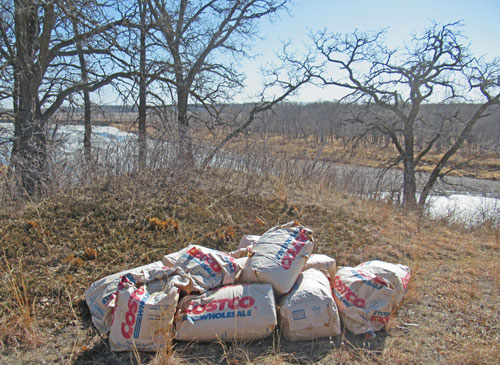
What a nice way to spoil a beautiful and significant location. Allowing access to vehicles make this sort of vandalism possible, perhaps inevitable.
What is needed is a comprehensive review of the purpose, use, and ultimate value of WMA’s.
The Case for the Enhancement of Wildlife Management Areas
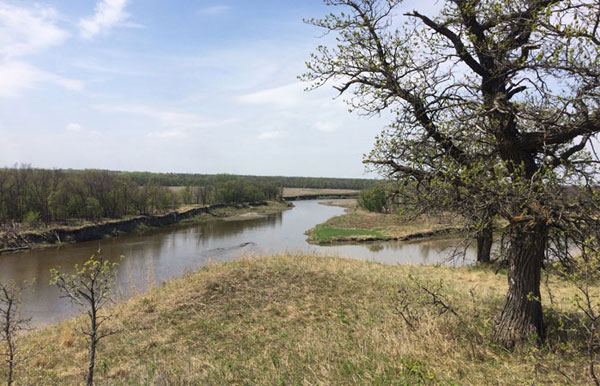
Souris Mouth is a rare location. A pleasant walk takes you to a magnificent view of the intersection of the two major rivers. Why is the spot not protected?
Upstream from the mouth, steep cliffs overlook the river bends and quick drops in elevation produce rapids at regular intervals. There are places here that defy the stereotype of the "prairie landscape".
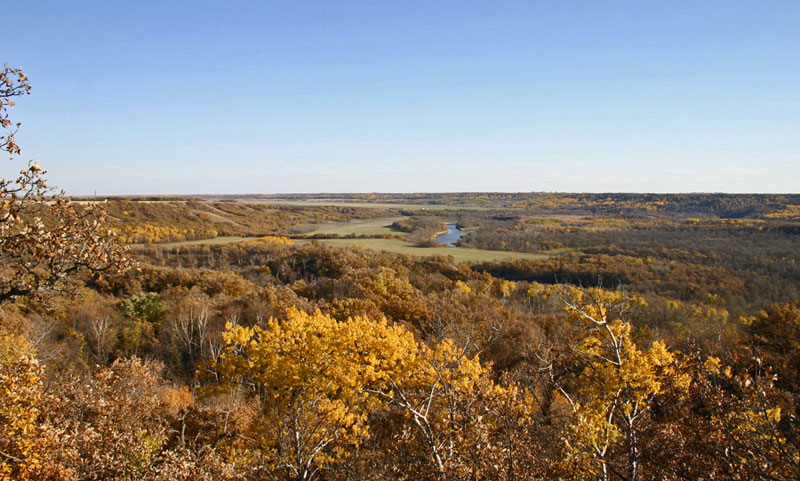
The Souris Bend Wildlife Management Area. A rare and extensive tract of unspoiled wilderness. Do we have the will to keep it that way?
The very attributes that make this a special place for the wilderness enthusiast, the wildlife enthusiast, the hiker and paddler, make it unsuitable for cultivation - and that is a happy circumstance. There are no homes, no roads, no hydro lines, and no cultivated fields. It is possible to walk (or canoe) for miles without encountering any of the usual noisy, smelly, intrusive ways in which we humans mark our territories. Or, it was once possible, and it could be possible again.
Miles of rough trails take you across the prairie grassland, along the ridge of the escarpment with its panoramic views of the river valley, down the valley walls, and along the river itself.

Upstream from historic Lang’s Crossing. The Souris Bend has a vast series of equestrian / hiking trails and countless places to view the Souris River Valley.
The Manitoba Government Website makes the purpose of Wildlife Management Areas clear:
"Wildlife Management Areas exist for the benefit of wildlife and for the enjoyment of people. They play an important role in biodiversity conservation and provide for a variety of wildlife-related forms of recreation, including birding and wildlife watching. Hunting and trapping are generally permitted in WMAs, but these activities may be prohibited or restricted in a few areas. The use of vehicles, off-road vehicles, watercraft, power boats, or airboats, may be restricted in some areas. WMAs are open year round and have no entrance fees."
We spend billions on highways, millions on full-service campgrounds, millions on Wellness Centres, swimming pools, ice rinks, paved walk and bike paths, spray parks, etc. while spending very little (and it would take very little) to make the best use of our natural areas. With just a little bit of investment, and a bit of promotion, they could be a much bigger part of a healthy community agenda. With a little supervision, regulation and enforcement they could become a low-cost / high value place to experience the natural world.
How Should WMA’s be Used?
An important first step would be to restrict the use of both guns and motor vehicles, except under carefully considered conditions.
While hunting is appropriate in most in most WMA’s. There is a case to make that some of the locations, such as the Brandon Hills WMA, which is close to a city and used in all seasons, is inappropriate for any use of firearms.
In areas where hunting is allowed, hunters will insist that they need access by motor vehicles and that may be appropriate.
But with the exception of specific hunting seasons, there is no reason to allow either guns or motor vehicles in any WMA. The use of both, contradicts the very purpose, the very name, ”Wildlife Management Area”.
A government publication entitled “Manitoba’s Protected Areas Initiative” helpfully informs us that”
“the Use of Wildlife Lands Regulation prohibits ”activities that significantly and adversely affect habitat in the areas specified.”
It seems pretty clear to me that neither motor vehicles nor gunfire is “for the benefit of wildlife” and that both would indeed, “significantly and adversely affect habitat in the areas specified.”
Should there be exceptions? Certainly.
A location such as Souris Mouth, historically significant and dramatically beautiful, requires a fair walk. Perhaps to make the site available for people who aren’t up to the hike we could allow vehicles along a well-defined trail and a designated parking spot.

The trail to Souris Mouth
When deciding the nature of restrictions we need to consider the size, location, historical and ecological significance, as well as the natural features of each WMA location.
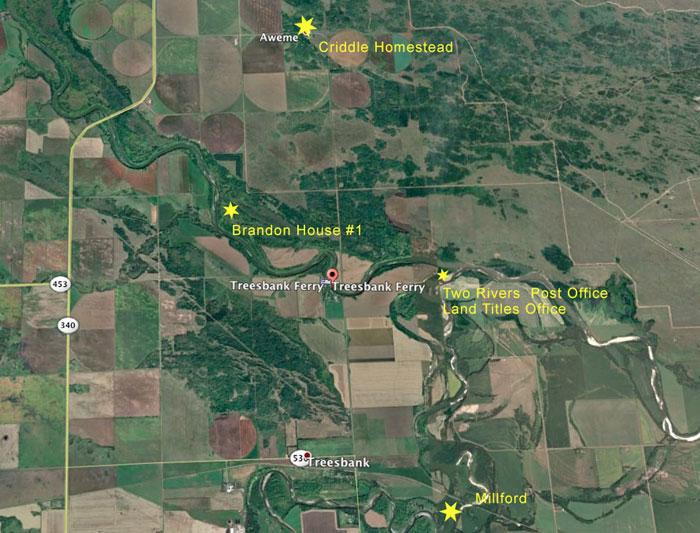
The area is rich in history. It deserves better care. The first Land Titles Office (1880) in the Westman was there. The First HBC Trading Post (1793) was nearby. Millford, the first village in south of the Assiniboine River in Westman, the childhood home of Nellie McClung, was just to the south. In her memoir, “Clearing in the West”, she vividly recalls crossing the Assiniboine near Souris Mouth as they approached her new home. The Criddle/ Vane Provincial Heritage Park is just to the north.
When setting both restrictions and goals for individual WMA’s, we need to encourage partnerships with local organizations. The Brandon WMA is favoured by Cross-Country Skiers and Hikers. The Souris Bend WMA has benefitted by the involvement of Equestrians. The rules need to reflect partnerships with user groups.
Taking a Closer Look at “Appropriate Activities” and Broader Issues.
The concept of “appropriate activities” was recently brought to light in an interesting fashion.
The equestrian group that has created, maintained and enhanced trails in the Souris Bend WMA, was informed that ATVs would be allowed improved access to some portions of the WMA. It appears that an ATV Association lobbied the provincial government for a change to a long-standing policy. The equestrians certainly hadn’t been consulted. The media was alerted and ran the story, while the Friends of Souris Bend Facebook Group sponsored a petition and letter writing campaign to get the government to reconsider. The petition was very well supported and within days the government reported to all that there would be no improved access for ATV’s .
On the surface, it would appear that this was good news story, but this little episode is part of a much larger issue, and I am very afraid that the Earth, and those of us that care about its health, are losing that battle.
A subset of the battle to save the planet is the divide between those of us who prefer earth-friendly recreational activities and those who choose activities that harm the earth and, in the process, often harm and annoy any nearby humans and wildlife.
The battle between ATV owners and hikers, for instance, is not as simple as two groups vying for their right to enjoy their pastimes. Having government treat it that way deflects our attention from the deeper issues.
It’s not just that I object to having my safe, peaceful, and quie hike interrupted by a passing ATV. It’s that the environmental, health, and safety impacts of our respective lifestyle choices are in no way comparable. And that matters. It matters deeply when it comes to public policy.
It is long overdue for all levels of government to come out strongly in support of earth-friendly options in all aspects of life.
By, in effect, ignoring the environmental side of an issue, governments can sidestep it and pretend that it is just a battle between two competing interests.
My letter to the local MLA and two other cabinet ministers went like this:
My family and I have been hiking and paddling in the Souris Bend Wildlife Management Area for decades, and we strongly object to allowing the use of motorized vehicles of any type in that beautiful and unique area.
Those of us who choose to enjoy nature in a peaceful, non-intrusive way are finding it increasingly difficult to find places to escape from the noise and pollution of modern-day life.
At a time when the earth is on the verge of a climate catastrophe our governments should be doing everything possible to encourage earth friendly activities. ATV's, in particular, are incompatible with hiking and equestrian activities, and it was the equestrian group that did the work in developing and maintaining the trails through this amazing landscape
The response from the Minister in charge read:
The Province of Manitoba recognizes that multiple user groups have interest in this area. We also recognize the ecological importance of the area, and will continue to consider impacts to wildlife and habitat as we move forward.
Historic vehicle access along existing Designated Vehicle Trails and use of equestrian trails by non-vehicle users is being considered, including where these trail networks currently overlap. We are reviewing the Designated Vehicle Trail and equestrian trail system to ensure the safety of all users, while at the same time taking steps to limit off-trail activity. No decisions have been made regarding the trail network, and no regulatory changes have been made to the Designated Vehicle Trail system. There is no intent to expand or promote the recreational use of ATVs in the Souris River Bend WMA.
We appreciate your views on the issue. Manitoba is in the early stages of public consultation and will continue to work with various user groups and adjacent landowners to develop a reasonable solution.
The opening sentence referring to “multiple user groups” sets the parameters for the discussion. Recognizing the “ecological importance” is a nod to the fact that the environment exists, and can henceforth be ignored. Instead “the safety of all users” is a consideration.
The province’s written statement provided to the Brandon Sun, notes that:
“At this time the province is working with stakeholders and trail users but no final decisions on trail allocations have been made.”
We’re all just “stakeholders” – we all have rights.
So a “sport” that pollutes the environment, kills a few people per year, disrupts wildlife, endangers hikers and equestrians, and is unhealthy for the both the user and anyone they encounter, is on some sort of level playing field with a sport such as hiking which, in terms of environmental impact and the health of both user and observer, does the opposite.
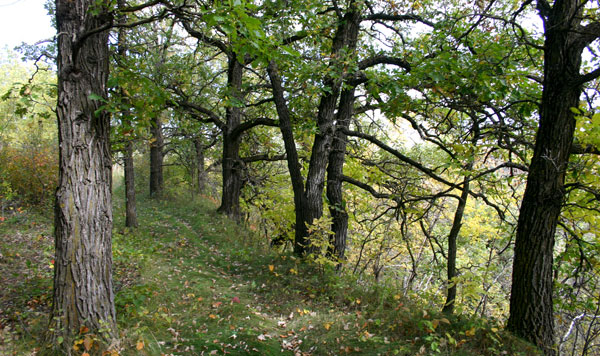
Trails used by hikers leave a minimal footprint.
This is the story of governments that consistently encourage, and even subsidize, behaviors that are starkly at odds with any pretense of taking action on climate change and health.
When I sent my concerns to government, I included the Minister of Conservation.
Her team sent me a prompt reply, explaining that, “ this matter falls under Honourable Blaine Pedersen, Minister of Agriculture and Resource Development, I have taken the liberty of forwarding your email for their review.”
The reply speaks volumes about why we continue to avoid dealing with the impending climate disaster.
I replied to this message by suggesting that:
“In fact, the issue of the appropriate use of Wildlife Management Areas is, almost by definition, about the natural world, and thus the Minister of Conservation and Climate should be at the table when decisions are made.
In fact, it should be the job of the Minister of Conservation and Climate to advise all branches of government as to the sustainability of all policies. The reason we are facing an environmental catastrophe is in large part because individual government departments see it as someone else's problem.
If there are people in government who see no problem with encouraging people to use gasoline-powered toys, to the detriment of people who make more earth-friendly recreational choices, then that helps to explain the continuing, accelerating, degradation of the natural world that is happening right before our eyes.
If the Minister of Conservation and Climate won't be a voice on behalf of the earth, what is the purpose of the department?”
So far…no response.
What Should Government Do?
Politicians like to say that their duty is to enact the will of the people. They will also admit that the role of government is also to protect the rights of the powerless and minorities. Progressive governments around the world are beginning to acknowledge that they have a duty to protect the earth.
Therefore, if it appears that the will of the people is to infringe upon the rights of the powerless or to damage the earth, some action might be required.
So?
Although I prefer to enjoy natural places on foot, and would find donning a helmet and riding on an ATV as simply spoiling a perfectly beautiful day, that’s just my opinion. ATV enthusiasts have every right to pursue their perfectly legal hobby, but there is no place for them in ecologically sensitive locations, and there is certainly no need to generally encourage and subsidize ecologically damaging activities of any sort. How is providing government owned land as their playground not subsidizing the activity?
Our governments have a duty to at least not go on pretending that our choices relating to the earth, to health and safety, and to the well-being of our neighbours, are somehow value neutral or with out far-reaching consequences. Now is the time for our governments to place a little more emphasis on providing safe, accessible places for earth-friendly activities.
Governments should also more clearly message the truth about climate change and the hundreds of daily decisions we all make that make a difference. They need to begin clearly encouraging earth friendly (human friendly) choices. They have to do more than suggest, they have to deploy clearly obvious carrots and sticks. They haven’t begun to do this.
The first step is admitting you have a problem.
In Summary
We urgently need our government to review the use and abuse of WMA’s.
WMA’s are a good place to start putting the environment first, and to start promoting healthy recreational alternatives.
We need to stop encouraging recreational activities that have negative effects on the environment and human health, and stop penalizing those who prefer more healthy sustainable activities.
The further degradation of sites that are ecologically and historically significant can be virtually eliminated by a few simple steps. Restrict the use of both motor vehicles and guns, and enforce the rules. Does anyone really think that the litter, vandalism and habitat damage that I have documented was caused by hikers? Bluntly put, people with guns and people with vehicles are causing the problem. Period. No one is saying that all gun owners and people who use vehicles are to blame, but allowing the activities, except under carefully considered conditions, is contrary to the stated purpose of the WMA’s.
 |
 |
 |